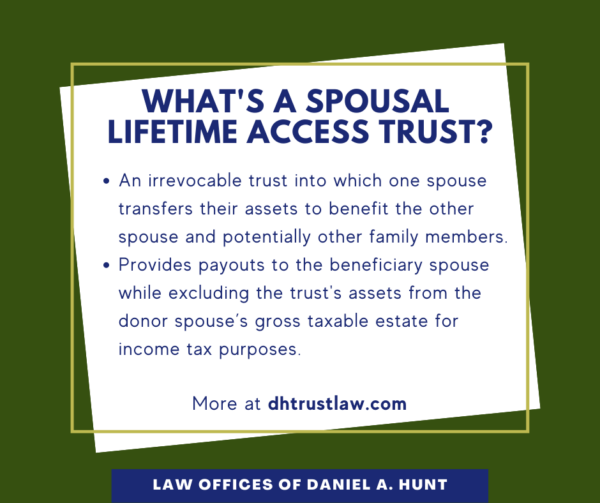What is a SLAT (Spousal Lifetime Access Trust)?

In 2022, the federal estate tax exemption is $12.06 million per individual or $24.12 million per couple. But in 2025, the exemption amount will drop back down to the prior law’s $5 million cap, which when adjusted for inflation is expected to be about $6.2 million. If you’re a couple with a large estate, a Spousal Lifetime Access Trust can help reduce your tax liability.
What is a Spousal Lifetime Access Trust?
A Spousal Lifetime Access Trust (SLAT) is an irrevocable trust into which one spouse (the donor) transfers assets to benefit the other spouse (the beneficiary) and potentially other family members. This trust provides payouts to the beneficiary spouse while excluding the trust’s assets from the donor spouse’s gross taxable estate for income tax purposes.
The beneficiary spouse may serve as trustee, or a third party may be named. If the spouse is named as trustee, their power to make distributions to themself must be limited to health, education, maintenance, and support. The primary trust beneficiary of the SLAT is the donor’s spouse, although additional heirs like children or grandchildren may also be named as either current or remainder beneficiaries.
How a SLAT Works
How does a SLAT work? Here’s an overview of the mechanics.
Step 1: The donor spouse transfers assets of which they are the sole owner into the trust and reports it on their gift tax return. Since California is a community property state, they may need to first convert community property assets into separate property assets using a partition agreement.
Step 2: Once the SLAT is funded, the beneficiary spouse can request distributions of income or principal (which also may indirectly benefit the donor spouse).
Step 3: When the SLAT is terminated (usually upon the death of the beneficiary spouse), any remaining trust assets pass to the remainder beneficiaries named in the trust document.
Which Assets Can Be Transferred to a SLAT?
A SLAT can be funded with a variety of assets, so long as they are owned solely by the donor spouse, such as:
- Cash
- Life Insurance
- Real Estate
- Securities
- Business Interests
Ideally, you would transfer assets that are likely to appreciate in value. If you were to transfer an asset to a SLAT that later depreciates in value, you might have wasted part of your lifetime gift and estate tax exemption. But if you were to transfer an asset to a SLAT valued at $1 million that later appreciated to $5 million, that $4 million appreciation is outside your taxable estate, even though you only used $1 million of your exemption.
Beware the Reciprocal Trust Doctrine
In order to fully utilize both spouses’ estate and gift tax exemptions, a married couple may plan to have each spouse create a SLAT for the benefit of the other. However, beware of the Reciprocal Trust Doctrine that applies when the IRS interprets two trusts as constructively similar or interrelated. If the IRS decides the two SLATS are reciprocal, the trusts’ contents may be included in the donor spouses’ taxable estates.
Always consult with an experienced estate planning attorney when creating a SLAT, especially when creating two SLATs for a married couple. You might consider creating and funding the trusts at different times, including different classes of beneficiaries, providing different terms for beneficiary distributions, giving beneficiaries different rights of withdrawal, or granting beneficiaries the power to change beneficiaries under certain restrictions.
Potential Drawbacks
One potential drawback to creating a SLAT is that if your spouse were to suddenly pass away, you would lose your indirect access to their SLAT payout. You would also lose access if you divorce, so you might consider adding a provision that states that your trust is for the benefit of your current spouse (and not former or estranged spouses). Once you remarry, you could regain indirect access to those assets.
One other potential drawback? Assets held in a SLAT don’t receive a step-up in cost basis when the donor spouse dies. This could potentially increase the remainder beneficiaries’ capital gains tax liability.
Creating a Spousal Lifetime Access Trust can get complicated with numerous aspects of tax law to consider. If you have any questions about SLATs, feel free to contact our office.
Law Offices of Daniel A. Hunt
The Law Offices of Daniel A. Hunt is a California law firm specializing in Estate Planning; Trust Administration & Litigation; Probate; and Conservatorships. We've helped over 10,000 clients find peace of mind. We serve clients throughout the greater Sacramento region and the state of California.




